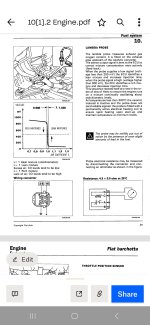The b-95 is now 29 years old, so I suppose all parts have the right to give up...
Symptoms:
The b-95 has always been eager to start during the two years I've known it, but this season, it is in need of "priming", ie activating the pump 2-3 times with the key (back and forth between OFF and MAR), maybe 50% of the time. The pump will activate every time judging by sound. The "priming" so far gets the engine to start every time.
This morning the engine stalled shortly after take-off (a first, while driving, taking a tight right corner). The engine started up again and completed a 7 minute journey without issues.
Before learning of the "priming" technique and within 36 hours of coming out of winter storage, the b-95 became extremely difficult to start. The first real cold start (0°C, plenty of moisture in the air) was no problem, but the second start-up took three tries and thereafter it took maybe ten tries. During these tries it would try to start maybe three times, and then die.
Additional:
Idle and acceleration is without hiccups as in failing spark(s).
No warning lights turning on (eg check engine, injectors)
Tank over half full
The fuel filter was changed 1-2 years ago (Ridex filter, mounted in the correct direction)
I have no idea of the fuel pump age
Questions:
Anything standing out? My primary suspects are; fuel pump, air leak after MAF, and/or crank shaft position sensor, thanks to @Ilkka. Are any of those more prone to failure? What about the fuel pressure regulator?
If changing the fuel pump, do you order/change the whole setup with housing and level indicator or just the actual pump? If changing the pump I suppose you need a new seal?
Am I missing something?
Thanks,
tjr
Symptoms:
The b-95 has always been eager to start during the two years I've known it, but this season, it is in need of "priming", ie activating the pump 2-3 times with the key (back and forth between OFF and MAR), maybe 50% of the time. The pump will activate every time judging by sound. The "priming" so far gets the engine to start every time.
This morning the engine stalled shortly after take-off (a first, while driving, taking a tight right corner). The engine started up again and completed a 7 minute journey without issues.
Before learning of the "priming" technique and within 36 hours of coming out of winter storage, the b-95 became extremely difficult to start. The first real cold start (0°C, plenty of moisture in the air) was no problem, but the second start-up took three tries and thereafter it took maybe ten tries. During these tries it would try to start maybe three times, and then die.
Additional:
Idle and acceleration is without hiccups as in failing spark(s).
No warning lights turning on (eg check engine, injectors)
Tank over half full
The fuel filter was changed 1-2 years ago (Ridex filter, mounted in the correct direction)
I have no idea of the fuel pump age
Questions:
Anything standing out? My primary suspects are; fuel pump, air leak after MAF, and/or crank shaft position sensor, thanks to @Ilkka. Are any of those more prone to failure? What about the fuel pressure regulator?
If changing the fuel pump, do you order/change the whole setup with housing and level indicator or just the actual pump? If changing the pump I suppose you need a new seal?
Am I missing something?
Thanks,
tjr


